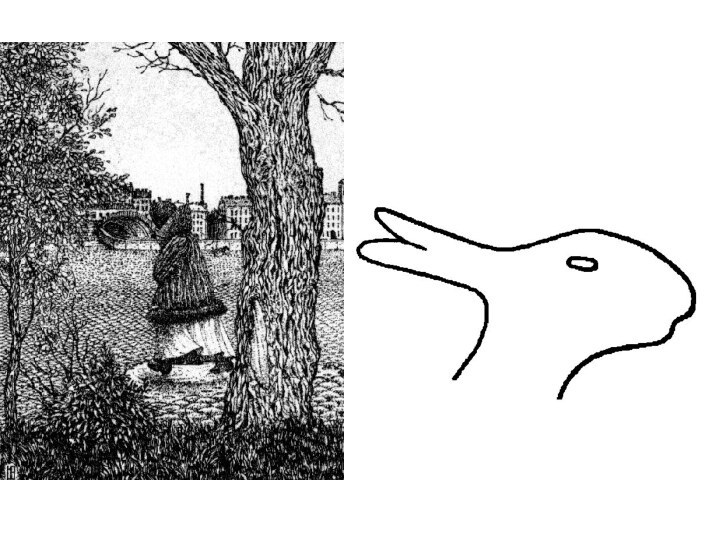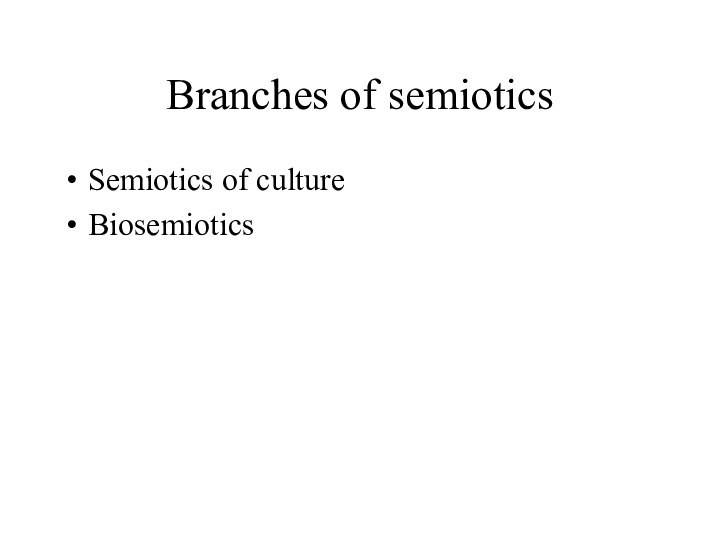Слайд 2
предвременная биосемиотика
Kalevi Kull
Тартуский университет
Отдел семиотики
kalevi@ut.ee
Слайд 3
1992 – 2008
semiotics
physics
Слайд 4
Semiosis
= sign process
(C. S. Peirce)
= interpretation
= translation
= life process (biosemiotic program)
Sebeok’s Thesis
life and semiosis are coextensive
Слайд 6
Sebeok’s Thesis
“All, and only, living entities incorporate
a species-specific model (umwelt) of their universe; signify; and
communicate by […] signs” (Sebeok 1996: 102).
“Because there can be no semiosis without interpretability – surely life’s cardinal propensity – semiosis presupposes the axiomatic identity of the semiosphere with the biosphere” (Sebeok 2001: 68).
Слайд 7
Minimum systems in which meaning arises
Complementary models of
semiosis
Jakob v. Uexküll
Juri Lotman
Слайд 9
Semioses create umwelten
Jakob von Uexküll 1864–1944
Слайд 10
Juri Lotman 1922–1993
.. and semiosphere
Meaningful communication assumes non-translatability
Слайд 11
Semiotic threshold
Umberto
Eco 1976
Lower semiotic threshold (border of life)
Indexical threshold (border
of animal)
Symbolic threshold (border of culture & language)
Слайд 12
Aristoteles – De anima
Thomas Aquinas, etc.
anima vegetativa
anima sensitiva
anima
rationalis (intellectiva)
Слайд 13
semiosphere – sphere of life
F. S. Rothschild 1962
- biosemiotic
T. Sebeok 1963 - zoosemiotic
M. Krampen 1981 -
phytosemiotic
Borders of human
Borders of animal
Borders of plant ...
Слайд 14
Autocatalysis
A + R → B
B → A +
A
Autocell
autocatalysis + self-assembly
autoreproductive systems – without semiosis
Semiosis requires codes
Слайд 15
Semiosis is …
conveyance of relations
inheritance of needs
(need
is a recognition of absence)
what makes a difference
(Bateson’s
‘difference that makes a difference’)
responsible for qualitative diversity
Слайд 16
What are the principal types of sign systems
in the realm of life?
Which are the main types
of umwelt?
Who owns a space?
Who owns a time?
What are the mechanisms of stability in semiotic systems?
Слайд 17
Towards a theoretical biology 1968–1972
Towards complexity science
Stuart Kauffman,
Michael Arbib
Rene Thom
Towards biosemiotics
Brian Goodwin
Howard Pattee
Conrad Hal Waddington
From stereochemistry
to code
Code as a part of of the mechanism of agency, and semiosis
Cell as a system that has needs (semiosis — intentions)
A need = recognition of absence
Слайд 18
Simple social phenomena and categorization as a result
of iconic semiosis
Biological species
Tissues
Organic form
Organism as a swarm
Herds
Flocks
Families
Recognition concept
of species (H. Paterson)
Perceptual categorization
Once communication is introduced, the discretization follows
Слайд 19
Indexical semiosis
associative learning
indexical relations
create spatial umwelten
Слайд 20
1997
Symbolic threshold – symbolic semiosis
Слайд 21
animal symbolicum – Ernst Cassirer
signifying animal –
Irmengard Rauch & Gerald Carr
semiotic animal – John Deely
& Susan Petrilli & Augusto Ponzio
Слайд 22
Vegetatative semiosis is based on the ability to
recognize, or iconicity. [quality]
pure recognition, nonspatial umwelt
Animal semiosis is
based on the ability to associate signs, or indexicality. [action of opposition]
spatial umwelt, orientation
Propositional semiosis is based on the ability to combine signs freely, or symbolicity. [synthetic thought]
temporal umwelt, language, narratives
Слайд 23
Biosemiotics is a study of (translation of)
non-symbolic texts
non-temporal umwelten
non-propositional discourse
Слайд 24
First, by publishing and teaching as much as
possible; and, equally important, by doing one’s best to
facilitate the success of one’s colleagues in these respects. These are the only things I have ever wanted to do in my academic life.
[1991]
Слайд 26
Semiotics is:
Study of signs and sign systems and
sign processes or semioses
Study of meaningful communication
Study of qualitative
diversity
Knowing of knowing
Слайд 27
semiotics
Medical
John Locke
Husserl, Frege, Peirce
Saussure
Слайд 28
Problems
Roland Posner (Presidental address in Semiotics Congress, 2000):
Semiotics
is the physics of the XXI century
Robert Rosen (Life
Itself, 1999: 105):
Life poses the most serious kinds of challenges to physics itself.
John Locke (An Essay Concerning Human Understanding, 1690):
Science may be divided into three sorts.
Слайд 29
John Locke
Chapter XXI
Of the Division of the Sciences
‑1.
Science may be divided into three sorts. All that
can fall within the compass of human understanding, being either, First, the nature of things, as they are in themselves, their relations, and their manner of operation: or, Secondly, that which man himself ought to do, as a rational and voluntary agent, for the attainment of any end, especially happiness: or, Thirdly, the ways and means whereby the knowledge of both the one and the other of these is attained and communicated; I think science may be divided properly into these three sorts:--
Слайд 30
‑2. Physica. First, The knowledge of things, as

they are in their own proper beings, their constitution,
properties, and operations; whereby I mean not only matter and body, but spirits also, which have their proper natures, constitutions, and operations, as well as bodies. This, in a little more enlarged sense of the word, I call Phusike, or natural philosophy. The end of this is bare speculative truth: and whatsoever can afford the mind of man any such, falls under this branch, whether it be God himself, angels, spirits, bodies; or any of their affections, as number, and figure, &c.
‑3. Practica. Secondly, Praktike, The skill of right applying our own powers and actions, for the attainment of things good and useful. The most considerable under this head is ethics, which is the seeking out those rules and measures of human actions, which lead to happiness, and the means to practise them. The end of this is not bare speculation and the knowledge of truth; but right, and a conduct suitable to it.
Слайд 31
‑4. Semeiotike. Thirdly, the third branch may be

called Semeiotike, or the doctrine of signs; the most
usual whereof being words, it is aptly enough termed also Logike, logic: the business whereof is to consider the nature of signs, the mind makes use of for the understanding of things, or conveying its knowledge to others. For, since the things the mind contemplates are none of them, besides itself, present to the understanding, it is necessary that something else, as a sign or representation of the thing it considers, should be present to it: and these are ideas. And because the scene of ideas that makes one man's thoughts cannot be laid open to the immediate view of another, nor laid up anywhere but in the memory, a no very sure repository: therefore to communicate our thoughts to one another, as well as record them for our own use, signs of our ideas are also necessary: those which men have found most convenient, and therefore generally make use of, are articulate sounds. The consideration, then, of ideas and words as the great instruments of knowledge, makes no despicable part of their contemplation who would take a view of human knowledge in the whole extent of it. And perhaps if they were distinctly weighed, and duly considered, they would afford us another sort of logic and critic, than what we have been hitherto acquainted with.
Слайд 32
‑5. This is the first and most general
division of the objects of our understanding. This seems
to me the first and most general, as well as natural division of the objects of our understanding. For a man can employ his thoughts about nothing, but either, the contemplation of things themselves, for the discovery of truth; or about the things in his own power, which are his own actions, for the attainment of his own ends; or the signs the mind makes use of both in the one and the other, and the right ordering of them, for its clearer information. All which three, viz, things, as they are in themselves knowable; actions as they depend on us, in order to happiness; and the right use of signs in order to knowledge, being toto coelo different, they seemed to me to be the three great provinces of the intellectual world, wholly separate and distinct one from another.
THE END
Слайд 33
Deely, John 2001. Four Ages of Understanding. Toronto:
Toronto University Press.
I Greek – semiotics and science not
distinguished
II Latin – semiotics without science
III Modern – science without semiotics
IV Post-modern – science with semiotics
Слайд 34
The end of modernism
John Deely (2001). Four Ages
of Understanding. Toronto: University of Toronto Press.
John Deely (2005).
Basics of Semiotics. 4th ed. Tartu: Tartu University Press.
Greek – Latin – Modern – Postmodern
Modern: sociobiology, semiology, Saussure
Ultramodern: Derrida
Postmodern: semiotics, Peirce, Uexküll, ecophilosophy
Слайд 35
The ending of modernism in physics
Quantum physics –
the role of observer
N. Bohr’s complementarity principle
J. Horgan (1996).
The End of Science.
H. J. Pirner (2002). The semiotics of “postmodern” physics. In: M.Ferrari & I.-O.Stamatescu (eds.), Symbol and Physical Knowledge. Berlin: Springer, 211-229.
Interdisciplinarity
Слайд 36
The ending of modernism in biology
Rosen, R.; Pattee,
H. H.; Somorjai, R. L. 1979. A symposium in
theoretical biology. In: Buckley, Paul; Peat, F. David (eds.), A Question of Physics: Conversations in Physics and Biology. Toronto: University of Toronto Press, 84–123.
“What is important in biology is not how we see the systems which are interacting, but how they see each other.” (Rosen et al. 1979: 87)
where the partition between “system” and observer is drawn is entirely arbitrary. (Rosen 1999: 86)
Ecological web (of mind):
our self would include our umwelt, our ecosystem.
Слайд 37
Physical versus Semiotic
Φ-sciences v. Σ-sciences
All qualitative
is in its last end reducable to quantitative. Science
means measuring. Physical space is commensurable.
Quantitative methods are supplementary, to find out the qualitative differences.
Semiotic space (semiosphere) is incommensurable.
Слайд 40
Mathematics & idealizations
Louis H. Kauffman –
The one
and the many.
Cybernetics and Human Knowing 12: 159-167.
Слайд 41
singletons
A set with single element
Element L
Singleton set {L}
Слайд 42
Principle of collection – any sets that already
exist can be selected as members of a new
set that is created from them
L
{L}
{{L}}
{{{L}}}
...
{L, {L}}
{L, {L}, {L, {L}}
...
Слайд 43
Semiotic world – singletons are distinct from their
members
Physical world – the difference between singleton and its
element collapses
Note. Mathematical world is semiotic – the world of relations and possibilities. This creates a permanent tension between mathematical description and purely physical world.
Слайд 46
Physical
approach
(law-based)
Non-living realm
(faultless)
Semiotic
approach
(code-based)
Living
realm
(erroneous)
Слайд 47
Branches of semiotics
Semiotics of culture
Biosemiotics
Слайд 48
The fourth Age:
Co-existence of science and semiotics
The world
is locally plural








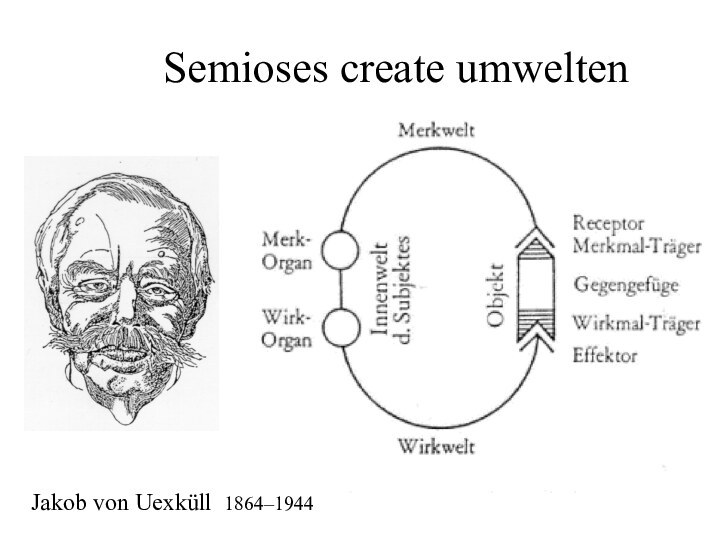







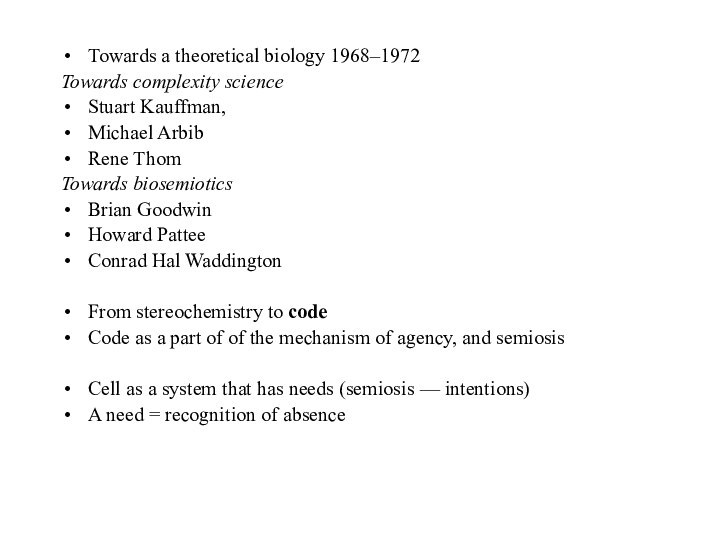

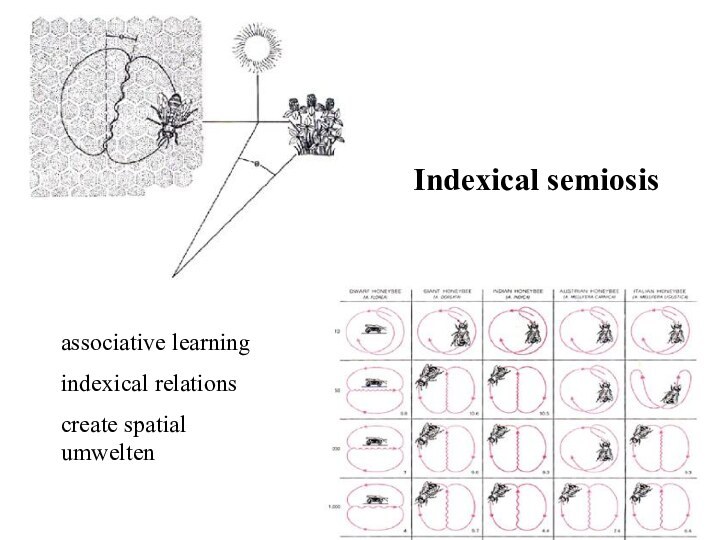


![Семиотический поворот в биологии и биологический поворот в семиотике Vegetatative semiosis is based on the ability to recognize, or iconicity. [quality]pure](/img/tmb/15/1429016/f6cb2ae524165b906f698564881dec85-720x.jpg)















![Семиотический поворот в биологии и биологический поворот в семиотике Φ-sciences v. Σ-sciences[1]](/img/tmb/15/1429016/e8a0d08a719e43a9b54747d2d86a009a-720x.jpg)






